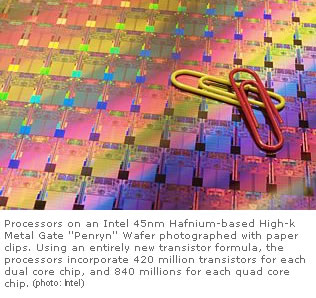|
|
Monday, November 12, 2007
|
Intel Launches new 45nm Penryn Processors
|
|
You are sending an email that contains the article
and a private message for your recipient(s). |
| Your Name: |
|
| Your e-mail: |
* Required! |
| Recipient (e-mail): |
* |
| Subject: |
* |
| Introductory Message: |
|
HTML/Text
(Photo: Yes/No) |
(At the moment, only Text is allowed...)
|
| |
|
| Message Text: |
Intel unveiled 16 server and high-end PC processors on Sunday made with the company's 45nm manufacturing process.
The chips are the first in the world to be mass-produced with a 45-nanometer process, about one-third smaller than current 65-nanometer technology.
Known by the project name Penryn, the chips hold little in the way of fundamental design advances but are an important step in continuing the industry's track record of delivering chips that get smaller and faster every two years or so.
They use Intel's Hafnium-based high-k metal gate (Hi-k) formula the company unveiled earlier this year in what was hailed as one of the industry's biggest advances in four decades.
Penryn is the "tick" in Intel's "tick-tock" strategy of shrinking an existing chip design to a smaller size, then following up the next year with an microarchitecture.
The new chips, to be sold under Intel's Xeon and Core 2 brands, are expected to run most software up to 15 percent faster.
 Intel's Penryn version for high-end computers, the Intel Core 2 Extreme QX9650 quad core processor (3GHz), features enhancements such as a larger L2 cache and support for new Intel SSE4 media instructions and promise to bring desktop performance to "extreme" new levels. It will sell for $999. Intel's Penryn version for high-end computers, the Intel Core 2 Extreme QX9650 quad core processor (3GHz), features enhancements such as a larger L2 cache and support for new Intel SSE4 media instructions and promise to bring desktop performance to "extreme" new levels. It will sell for $999.
Intel will initially sell a dozen versions of the chips for server computers that power corporate networks, with prices ranging from $177 to $1,279. The 12 new quad-core chips for servers boast clock speeds ranging from 2GHz up to 3.20GHz (Xeon X5482), with front side bus speeds (FSB) up to 1600MHz, and cache sizes of 12MB. The three new dual-core chips feature clock speeds of up to 3.40GHz (Xeon X5272), an FSB of up to 1600MHz, and cache sizes of 6MB.
The 45nm Xeon processors are compatible with server platforms using the Intel 5000 chipset family. In addition, Intel is launching three platform solutions to support 45nm processors, including:
- The Intel 5400 chipset-based platform (previously codenamed "Stoakley") that is optimized for high-bandwidth applications such as high-performance computing (HPC).
- The Intel 5100 Memory Controller Hub chipset and Intel ICH-9R I/O controller (previously codenamed "Cranberry Lake"). These are cost-optimized solutions that support either one or two processors and also provide reduced power consumption using native DDR2 memory.
- The Intel 3200 chipset-based platform (previously codenamed "Garlow") that is specifically designed for single-processor entry servers.
Additional architectural features include Enhanced Intel Virtualization Technology, Fast Division of Numbers and a
Unique Super Shuffle Engine.
Enhanced Intel Virtualization Technology -- Virtual machine transition (entry/exit) times are improved by an average of 25 to 75 percent through hardware with no changes to software required.
Fast Division of Numbers -- A fast divider roughly doubles the speed over previous generations for computations used in nearly all applications through a technique called Radix 16. The ability to divide instructions and commands faster increases a computer's performance.
Unique Super Shuffle Engine -- By implementing a wider 128-bit shuffle unit, performance significantly improves for SSE-related instructions that have shuffle-like operations. This feature will increase performance for content creation, imaging, video and high-performance computing.
"One of our goals was to optimize Crysis in order to deliver the ultimate quality, bringing mind-blowing game play to the latest hardware," said Dr. Douglas Binks, R&D manager, Crytek. "With the new 45nm Hi-k Intel Core 2 Extreme processors, we use multi-core technology to enable physics, particle effects and audio on separate cores, helping Crysis to create an astounding gaming experience."
The 45 nanometer shift is also important to Intel because it means the company can make more chips from a single platter of silicon, boosting productivity and helping recoup investment on factories, which cost about $3 billion to build.
The company expects to make the majority of its processors on 45 nanometer by the middle of 2008.
Today's news cement Intel's manufacturing lead over rival AMD, which only started making chips on 65 nanometers earlier this year but plans to try to roll out 45 nanometer technology in 2008. |
|
|
|
|